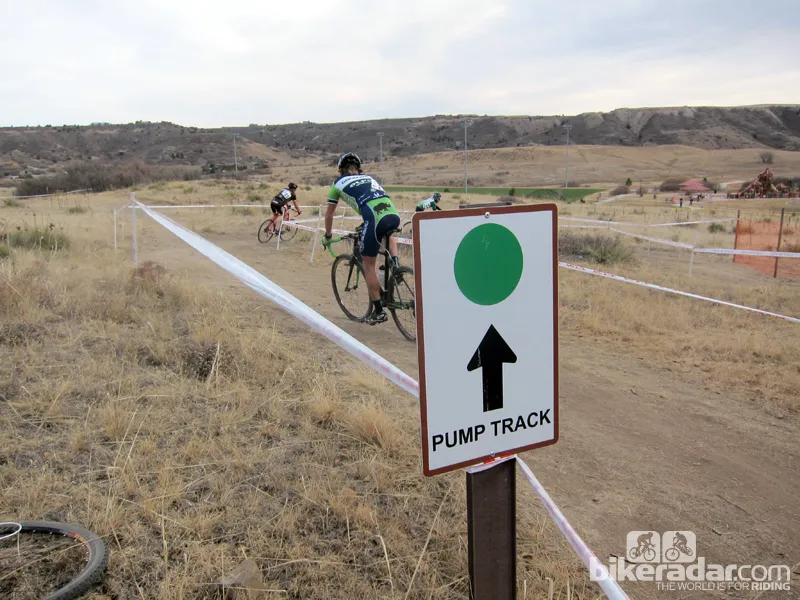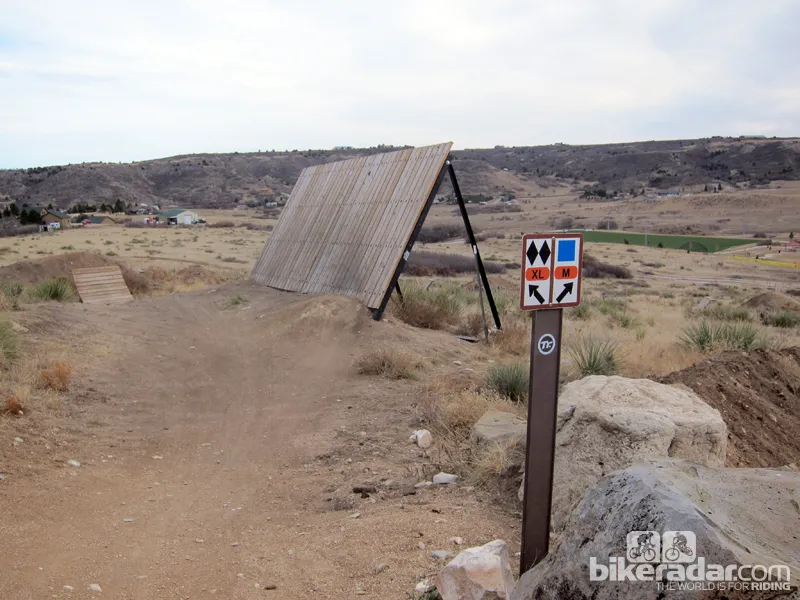The town of Caste Rock, Colorado, has found its Rhyolite Bike Park to be so popular that it continues to expand and add features.
In 2008, Castle Rock built the first phase of Rhyolite Bike Park with a beginner downhill flow-line trail with berms, rollers and jumps as well as a return trail back up to the top of the park. That first year the town sponsored its first downhill cycling event, the Rhyolite Downhill Challenge.
The bike park has continued to progress from there. Today Rhyolite Bike Park features multiple levels of trail riding, trail access, plus restrooms and even a picnic pavilion. And it continues to roll forward.
“Since then the town has added an intermediate downhill flow trail with large berms, rollers and tabletop jumps; an advanced jumpline with fabricated engineered structures including an 8-foot by 18-foot wall-ride and four 5-foot jumps lips; a small pump track, a mulch pit jump and a cyclocross course,” said Richard Havel, trails planner for the Town of Castle Rock Parks & Recreation Dept. “With these new features, the town gained recognition from many folks in the biking industry.”
Since the creation of the park many events have been sponsored by the town and local cycling clubs, including a recent cyclocross race.
And even with these improvements, Havel told BikeRadar there is much more to do.
“In 2013, the town will continue to expand the bike park by adding a two acre sessions zone which will include beginner, intermediate and advanced lines with both dirt and fabricated structures,” he added. “Also included with the new sessions zone will be the installation of an irrigation system with a network of quick couplers to help with maintaining the bike park.”

The Castle Rock bike park hosts regular events in addition to its everyday access
Havel also added that he believes this trend in bike parks is something that could benefit many communities.
“Just as skate parks filled a niche in the recreational industry in the 1970’s, so will bike parks,” Havel stressed. “Not all kids, or adults for that matter, have an interest in traditional team sport recreation. Bike parks are one way to get people active and outdoors.”
He isn’t alone in this line of thinking. Many communities around the country including Williamsburg, Va.; Pittsburgh, Pa.; Draper, Utah; Louisville, Ky.; and even New York City have created bike parks. Companies such as Alpine Bike Parks have led the efforts to create these unique places to ride – often providing places that residents wouldn’t readily have.
“There is a trend for all communities to build bike parks even in towns and areas that are covered in trails,” Grant Lamont of Alpine Bike Parks told BikeRadar. “These parks give young and novice riders a great chance to hone their skills as well as provide experienced riders with the opportunity to progress their skills with jump parks and skills areas that are also designed to challenge.”

Trails are marked by skill level
Additionally, towns without access to trails are not only building bike parks but also looking for places such as existing parks and moth-balled golf courses to create trail systems just like in Lost Lake in Whistler Lamont noted.
As with the Rhyolite Bike Park these facilities can offer riders other advantages as well.
“The bike park and multi-use trails are also designed within an existing park infrastructure with passive areas such as beaches for dogs and people along with utilizing infrastructure such as washrooms and parking that already exist,” said Lamont.
The bike parks can also be a way for riders of all levels to gain an appreciation of trail design, surfacing and maintenance.
“A good trail takes a little longer to build but when done correctly takes almost no maintenance,” emphasized Lamont. “When you look at other recreational amenities such as pools, arenas, playing fields etc. the money for operations is huge. I was a City Councillor in Whistler, and the one thing I learned during my tenure is that the capital cost is one thing but the operating costs are the killer. I also believe trails and parks introduce many new and novice riders to the need to progress with skills allowing them to ride trails with confidence causing less wear and tear.”
And one key to this is also build a sustainable park.
“If you design and plan a park/trail properly it will not only last a long time but also keep maintenance to a minimum,” Lamont noted. “Sustainable also means multi-use and adaptable so as to evolve with the constituents needs and desires. Having durable and flexible designs help to ensure that the trail and park system are progressing along with society.”
The bike parts can even be a way to get the community involved, as noted in how the Town of Castle Rock over the last few years has developed a volunteer program to assist with maintaining the parks, trails and open spaces.
The volunteer program at Rhyolite Bike Park has been adopted by the ‘Rhyolite Dirt Crew’ and is led by local bike shop, Castle Rock Ski and Bike, and the result has been a very successful collaboration. Havel noted that many of the users of the bike park are members of the Dirt Crew and these riders help to maintain the park, but also give input on the current and future developments.
“They not only help maintain, they help guide its development,” Havel added. “This has been a valuable asset to the town. The town would not have been able to get as far as it has without the efforts of this dedicated group.”
There is another aspect as well; not only can a bike park allow BMX and mountain bike riding in places where such activities can be confided to limited spaces, but it can even bring other types of riding that would be impossible outside of a park.
“Freeride Terrain Bike Parks are a new trend in the biking and recreation industries,” said Havel. “Not long ago, freeriding was only available at big mountain ski resorts, now several municipalities along the Front Range have built and continue to build and expand on these new biking facilities.”
The end result with all these options is that bike parks allow users to develop and gain new skills close to home without traveling long distances to get a ride in; and these can further add to the overall quality of life and gets people outdoors. And for some communities that helps the local economy.
“Bike parks also benefit local businesses by bring in users who will spend time and dollars in the area to have lunch after a great day of riding, pick up a snack or spare bike part,” said Havel.